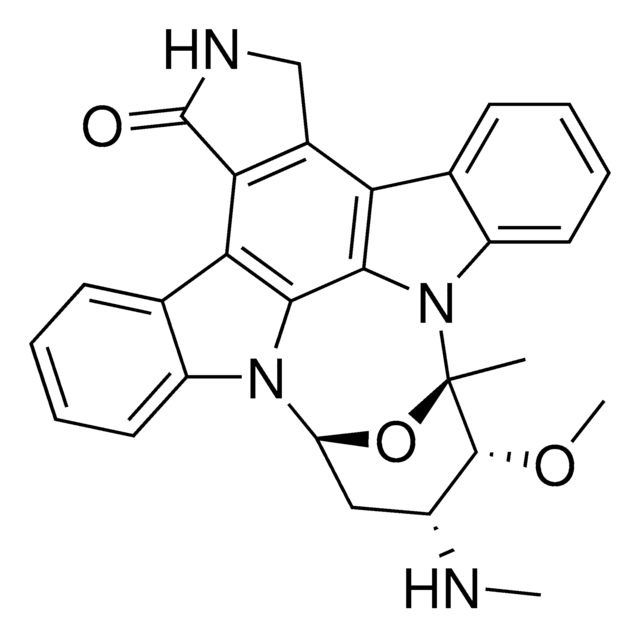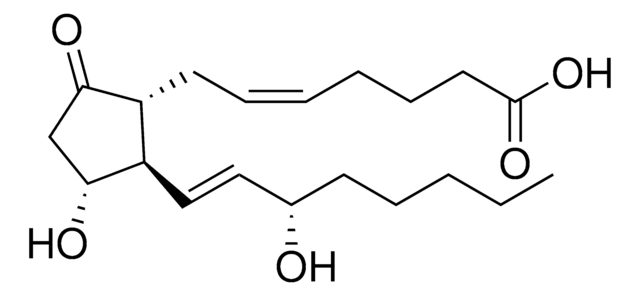S7076
SB 202190 monohydrochloride hydrate
≥98% (HPLC), solid, p38 MAP kinase inhibitor
Sinónimos:
4-(4-Fluorophenyl)-2-(4-hydroxyphenyl)-5-(4-pyridyl)-1H-imidazole monohydrochloride hydrate, 4-[4-(4-Fluorophenyl)-5-(4-pyridinyl)-1H-imidazol-2-yl]phenol monohydrochloride hydrate
About This Item
Productos recomendados
product name
SB 202190 monohydrochloride hydrate, ≥98% (HPLC)
Nivel de calidad
Análisis
≥98% (HPLC)
formulario
solid
condiciones de almacenamiento
desiccated
color
white to beige
solubilidad
DMSO: ≥12 mg/mL
emisor
GlaxoSmithKline
temp. de almacenamiento
2-8°C
cadena SMILES
O.Cl.Oc1ccc(cc1)-c2nc(-c3ccc(F)cc3)c([nH]2)-c4ccncc4
InChI
1S/C20H14FN3O.ClH.H2O/c21-16-5-1-13(2-6-16)18-19(14-9-11-22-12-10-14)24-20(23-18)15-3-7-17(25)8-4-15;;/h1-12,25H,(H,23,24);1H;1H2
Clave InChI
CZZOICWZVYZUNP-UHFFFAOYSA-N
Aplicación
Acciones bioquímicas o fisiológicas
Características y beneficios
Palabra de señalización
Warning
Frases de peligro
Consejos de prudencia
Clasificaciones de peligro
Eye Irrit. 2 - Skin Irrit. 2 - STOT SE 3
Órganos de actuación
Respiratory system
Código de clase de almacenamiento
11 - Combustible Solids
Clase de riesgo para el agua (WGK)
WGK 3
Punto de inflamabilidad (°F)
Not applicable
Punto de inflamabilidad (°C)
Not applicable
Certificados de análisis (COA)
Busque Certificados de análisis (COA) introduciendo el número de lote del producto. Los números de lote se encuentran en la etiqueta del producto después de las palabras «Lot» o «Batch»
¿Ya tiene este producto?
Encuentre la documentación para los productos que ha comprado recientemente en la Biblioteca de documentos.
Los clientes también vieron
Artículos
The mitogen-activated protein kinase (MAPK) family consists of both stress activated (SAPK) and mitogen-activated (MAPK) protein kinases. They form a network of signal transduction cascades that mediate cellular responses to a diverse range of stimuli, including growth factors, chemical or osmotic stress, irradiation, bacterial infection and proinflammatory cytokines.
Organoid culture products to generate tissue and stem cell derived 3D brain, intestinal, gut, lung and cancer tumor organoid models.
Nuestro equipo de científicos tiene experiencia en todas las áreas de investigación: Ciencias de la vida, Ciencia de los materiales, Síntesis química, Cromatografía, Analítica y muchas otras.
Póngase en contacto con el Servicio técnico

![[Leu15]-Gastrin I human ≥95% (HPLC)](/deepweb/assets/sigmaaldrich/product/structures/153/342/d4cb3dd7-13f1-46cf-8d1f-3907a5de7a83/640/d4cb3dd7-13f1-46cf-8d1f-3907a5de7a83.png)











